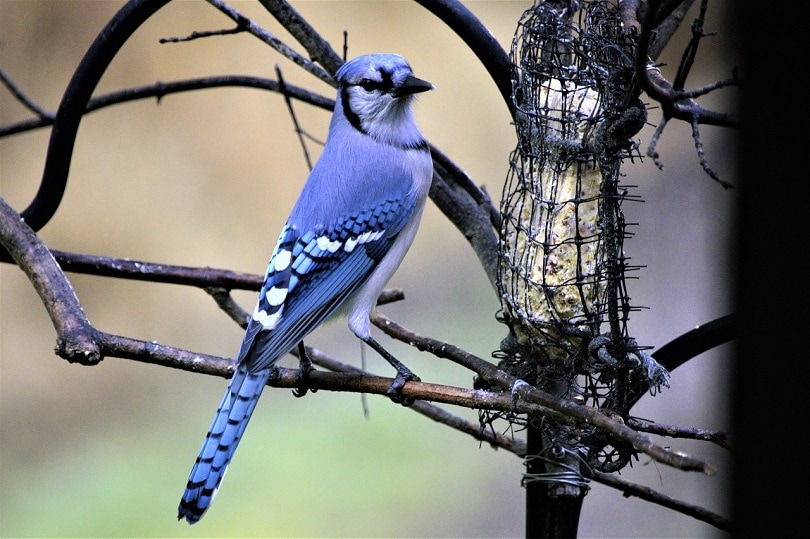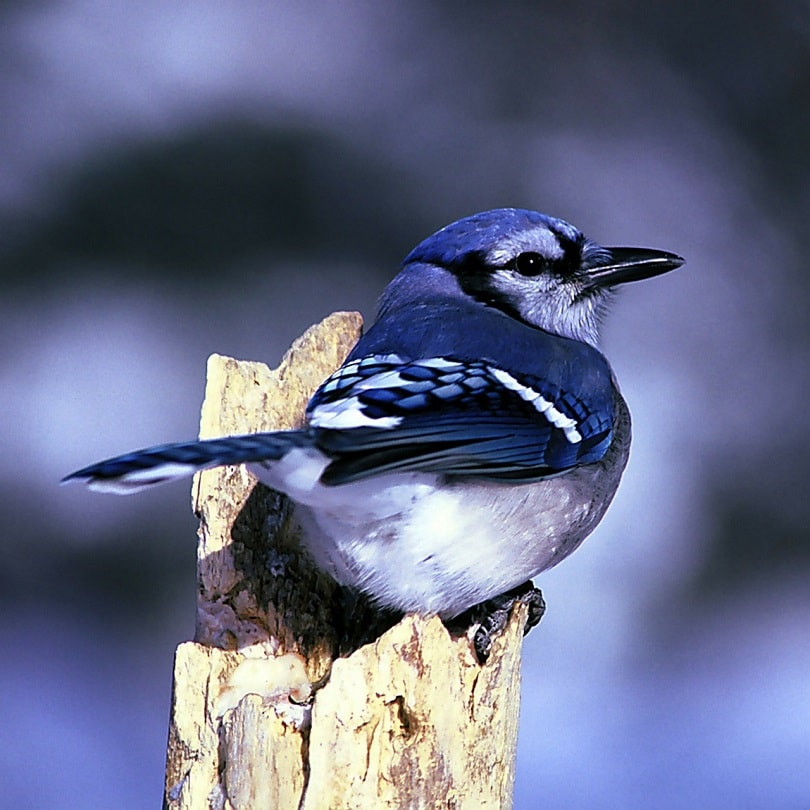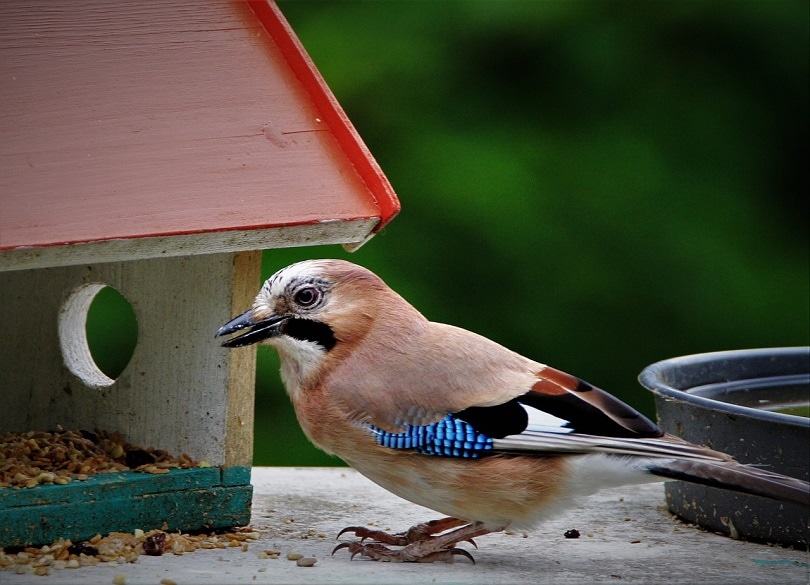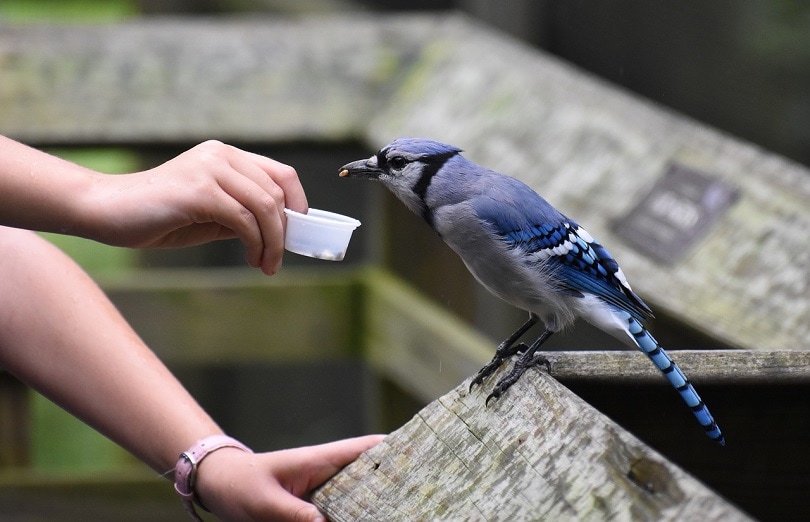7 Proven Ways to Attract Blue Jays to Your Yard – 2024 Guide
Last Updated on

In a way, Blue Jays are just like human beings. These birds are so intelligent in comparison to other birds, and the social systems that they’ve been known to be a part of are often complex in nature. They understand the importance of family bonds, and always fight hard to protect them should they feel threatened—We had to learn that last part the hard way.
At this point, you can obviously tell what we’ll be talking about today. So, instead of lollygagging, we’ll just jump right into it.
How to Lure Blue Jays to Your Yard:
1. Become a Chef De Partie

This method works almost all the time. If you’re contemplating turning your backyard into a Blue Jay residence, just let them know you know your way around the kitchen, by offering an irresistible buffet. How do we know this? The answer is simple:
When it comes to food, there’s no animal out there—be it mammal, fish, reptile, amphibian or even bird—that can help itself. This might not be public knowledge, but you should know animals are so obsessed with food and water. We had a conversation with a zoologist a couple of months ago, and what we learned was astounding.
So apparently, animals aren’t like us in the sense that they don’t understand the concept of the future. And due to that fact alone, they’ll never try to rationalize their drive to eat. In hindsight, that makes a lot of sense because those that we’ve seen trying to rationalize their food intake in the past, never survived the leaning period. Meaning, they never got the chance to pass on their genes.
That, coupled with the actuality of life in the wild where food is hard to come by, is the reason why they’ll hunt and eat whether they’re hungry or not. It’s more or less like an evolution thing that’s ingrained in their DNA.
So yes, if you want to win any bird’s loyalty, offer them their favorite treats. And in the case of a Blue Jay, those treats should have nuts in abundance. Particularly, the peanut, which they can have shelled or whole.
If peanuts are not an option, you can try the cherries, blackberries, suet, sunflower seeds, or mealworms. This type of diet will for sure keep them coming back for more.
2. Provide Nesting Materials

No, we’re not asking you to sign up for an ornithology class. Just spare some of your time to learn about how differently these birds behave during their nesting period.
In general, if it all boils down to their nesting habits, we have three types of birds. There’s the primary cavity nester, the secondary cavity nester, and the third kind that doesn’t fall in any one of those two categories.
By the way, cavity nesting by definition is a nesting technique. We’re pretty sure you’ve seen birds try to hollow out chambers mostly in dead tree snags just to lay eggs. Those are what we call cavity nests, and the birds are primary cavity nesters. A good example is the woodpecker.
And then we have the second kind. We like to refer to them as the lazy bunch, since they don’t like doing the work, but reaping the rewards. They’ll simply bully the primary cavity nester out of its cavity, or take advantage of an abandoned one. Those types of birds are called secondary cavity nesters, and a fine example is the House Wren.
Finally, we have the Blue-Jay-led group that doesn’t care about the cavity nesting technique, or even birdhouses. If they feel like it’s that time of the year, they’ll look for a good spot on the same tree that they’ve been using as shelter, and build a nest.
You can entice them to build nests in your backyard by providing the nesting materials. These materials include grass clippings, small sticks, and twigs. And the site has to be open and large enough to accommodate the breeding pair, nests—which are unusually large for such a small bird—and the hatchlings.
3. Quench Their Thirst, Clean Them Up

Newsflash: Birds need water the same way human beings do. And they not only need it to quench their thirst, but to bathe as well. This is especially important in the summer and winter, when finding adequate water in hotx weather is difficult, and most natural supplies are frozen.
You don’t have to supply them with an entire pool. Blue Jays do need clean water, but the amount should be significantly less compared to that consumed by humans or mammals in general. That’s because they don’t have sweat glands. The only way they get to lose water is usually through their droppings and respiration.
However, if we had to compare that amount to that of insectivorous birds, we would say Blue Jays require more water. Primarily because their main diet consists of dry seeds.
“Why’s bathing important to birds?”
Bathing is important as it helps them maintain healthy feathers. Feathers that are not in good shape are hard to preen. And just so you know, preening is a common bird practice. They’ll frequently do it, so as to take care of tough sheaths, and get rid of the different feather parasites.
Friendly reminder: Ensure that water is clean at all times. Don’t just leave it out there because eventually it will gather algae, dead leaves, and different other chemicals that will make it toxic to the birds.
4. Provide Shelter

You’re right. Most birds out there have the ability to survive the wild with minimal shelter. But, that doesn’t mean that they’d mind if people started offering safer alternatives.
Shelters are beneficial in two ways. One, they act as barriers and offer natural camouflage. So even if there’s a predator in sight, it cannot easily spot or penetrate those grasses and twigs to get to the Blue Jay. And even if they could, the birds will have more than enough time to react instead of being caught off guard.
Two, the birds will be well protected against harsh weather conditions. Of course, birds know how to regulate their body temperatures so as to stay cool or warm, but mitigating that storm effect by sheltering will go a long way in helping them conserve energy.
Side Note: If you’re trying to lure Blue Jays to your yard by using shelters, do your homework and learn about the type of trees that they love. The right tree is one that meets all the Blue Jays’ needs. That is adequate food, water, and a nesting site. Examples of such trees include the hickory tree, oak, berry shrubs, and beech. That thick-like landscaping is very important, as it helps birds feel a lot safer.
5. Choose the Appropriate Feeder

Blue Jays prefer feeding from stable feeders. You know, the type that doesn’t sway or swing around. In fact, any type of feeder that makes them feel uncomfortable in any way, will definitely discourage them from ever coming back. If we were you, we would go for the ground feeders or the pole-mounted ones that offer remarkable stability.
An adult Blue Jay will weigh approximately 3.5 ounces max. Therefore, if that feeder can’t comfortably support that weight, you need to build a different one or run back to the store.
6. Maintain Your Distance

Blue Jays are extremely territorial. And this is probably the first thing that you’ll learn the minute you spot them. They’ll bully any bird near them, and dive at anything moving including humans.
Do you want to see them eat? Get out your pair of binos and keep distance. If you stick around, they’ll never touch those peanuts, corn, suet, or sunflower. And if they sense you’re not going away anytime soon, they’ll start flying close to you. Just to express their level of discomfort.
7. Use Baffles

Speaking of territories, you do know squirrels love stealing bird food, right? Or were you under the assumption that since they have dissimilar taste buds, their diets are different as well?
We hate to break it to you buddy, but if you’ve noticed your peanuts have been missing, and you still haven’t seen any Blue Jay in your vicinity, it’s the squirrels.
And those birds won’t show up, unless you find a way to get rid of those pesky creatures. You could use baffles, or any other technique that you can think of, to bar them from getting to your feeders.
Related Read: 9 Birds That Look Like Blue Jays

Frequently Asked Questions
Where Are Blue Jays Found?
Blue Jays can be found anywhere in this country. They rarely migrate during the colder months, and the ones that do, are the younglings
Do they normally go back once the weather changes?
That question is hard to answer, since their movements are unpredictable. All we can say is, sometimes they do, other times they don’t. Also, it’s been reported that most Blue Jays don’t survive that migration. That’s because they become easy prey for predators such as the feral cats, hawks, and typical hunters.
How Many Species of Blue Jays Are There?
Let’s see… There’s the Stellar Jay, the Canada Jay, the Pinyon Jay, and the Green Jay. So, that makes five. But the most common Jay is the Blue Jay, and it’s mostly found in the eastern states. You can look for all the other species in southern Florida or in the western states.
Why Do They Mimic Hawks?
Every animal in the wild has some sort of survival technique that they often employ to scare away predators. For the Blue Jay, that technique is mimicking the sound made by hawks. However, they’ll only imitate the hawks if they feel threatened, or if they just want to mess around with annoying birds trying to steal their food. Like we said before, they are very territorial.
How Do They Survive Winter, If They Hate Migrating?
Blue Jays are well adapted to changes in regions that they’ve inhabited for years. When temperatures start dropping, they’ll start producing more feathers. And to make certain that they’re well insulated, they’ll use body oils to waterproof their feathers.
Say, those two methods aren’t as effective as they’d like, they’ll go into a hypothermia state, forcing their body temperatures to drop, and the heartbeat rate to slow down. This will be enough to help them survive the cold, while conserving energy.
- You might also like: 20 Types of Jaybirds

Conclusion
That’s all we had for you today. But before signing off, we’ll leave you with this interesting fact: The blue color that you see on the Blue Jay, is not actually the color of its feathers. It’s the result of light scattering through its feather barbs’ modified cells.
Check out some of our other top-trending posts:
- 13 Proven Ways to Attract Crows to Your Yard & Feeders
- 10 Best Monoculars for Bird-Watching– Reviews & Top Picks
- 8 Proven Ways to Keep Squirrels Out of Bird Feeders
Featured Image Credit: Scottslm, Pixabay
About the Author Robert Sparks
Robert’s obsession with all things optical started early in life, when his optician father would bring home prototypes for Robert to play with. Nowadays, Robert is dedicated to helping others find the right optics for their needs. His hobbies include astronomy, astrophysics, and model building. Originally from Newark, NJ, he resides in Santa Fe, New Mexico, where the nighttime skies are filled with glittering stars.
Related Articles:
How to Clean a Refractor Telescope: Step-by-Step Guide
How to Clean a Telescope Eyepiece: Step-by-Step Guide
How to Clean a Rifle Scope: 8 Expert Tips
Monocular vs Telescope: Differences Explained (With Pictures)
What Is a Monocular Used For? 8 Common Functions
How to Clean a Telescope Mirror: 8 Expert Tips
Brightfield vs Phase Contrast Microscopy: The Differences Explained
SkyCamHD Drone Review: Pros, Cons, FAQ, & Verdict
